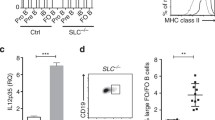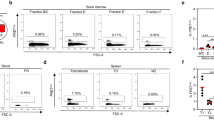Abstract
Natural antibodies produced by CD5+ B-1 B cells include those with specificity for senescent erythrocytes (anti-BrMRBC, anti-PtC) and for thymocytes (anti-thymocyte autoantibody, ATA). Here we describe work from our laboratories studying two prototypic examples, VH11Vκ9-encoded anti-BrMRBC and VH3609Vκ21c-encoded ATA. Using VH11-μ transgenic mice, we discovered that certain natural autoantibodies utilize VH genes that are selected against in bone marrow B cell development, but not fetal liver, effectively restricting their generation to fetal/neonatal life. Studies with ATA-μ transgenic mice demonstrated a critical requirement for self antigen in the accumulation of B cells with this specificity and for the production of high levels of serum ATA. Finally, analysis of B cell development in ATA-μκ transgenic mice revealed two distinct responses by B cells to expression of this B cell receptor (BCR): most developing B cells in spleen of adult mice were blocked at an immature stage and only escaped apoptosis by editing their BCR to eliminate the ATA specificity; nevertheless, high levels of serum ATA were observed, indicating that some B cells differentiated to antibody-forming cells without altering their specificity. Thus, our studies reveal mechanisms for restricting the generation of B cells producing natural autoantibodies, demonstrate a key positive selection step in their development, and show that most developing B cells in adult mice bearing such specificities fail to reach a mature stage.



Similar content being viewed by others
References
Hayakawa K, Hardy RR, Parks DR, et al (1983) The “Ly-1 B” cell subpopulation in normal, immunodefective, and autoimmune mice. J Exp Med 157:202
Hayakawa K, Hardy RR, Honda M, et al (1984) Ly-1 B cells: functionally distinct lymphocytes that secrete IgM autoantibodies. Proc Natl Acad Sci USA 81:2494
Sidman CL, Shultz LD, Hardy RR, et al (1986) Production of immunoglobulin isotypes by Ly-1+ B cells in viable motheaten and normal mice. Science 232:1423
Hayakawa K, Hardy RR, Herzenberg LA, et al (1985) Progenitors for Ly-1 B cells are distinct from progenitors for other B cells. J Exp Med 161:1554
Cunningham AJ (1974) Large numbers of cells in normal mice produce antibody components of isologous erythrocytes. Nature 252:749
Cunningham AJ, Steele EJ (1981) Ontogeny of the autoimmune reaction in normal mice to antigens in erythrocytes and gut. Clin Exp Immunol 44:38
Mercolino TJ, Arnold LW, Haughton G (1986) Phosphatidyl choline is recognized by a series of Ly-1+ murine B cell lymphomas specific for erythrocyte membranes. J Exp Med 163:155
Cox KO, Hardy SJ (1985) Autoantibodies against mouse bromelain-modified RBC are specifically inhibited by a common membrane phospholipid, phosphatidylcholine. Immunology 55:263
Hardy RR, Carmack CE, Shinton SA, et al (1989) A single VH gene is utilized predominantly in anti-BrMRBC hybridomas derived from purified Ly-1 B cells. Definition of the VH11 family. J Immunol 142:3643
Poncet P, Kocher HP, Pages J, et al (1985) Monoclonal autoantibodies against mouse red blood cells: a family of structurally restricted molecules. Mol Immunol 22:541
Reininger L, Ollier P, Poncet P, et al (1987) Novel V genes encode virtually identical variable regions of six murine monoclonal anti-bromelain-treated red blood cell autoantibodies. J Immunol 138:316
Ye J, McCray SK, Clarke SH (1995) The majority of murine VH12-expressing B cells are excluded from the peripheral repertoire in adults. Eur J Immunol 25:2511
Pennell CA, Arnold LW, Haughton G, et al (1988) Restricted Ig variable region gene expression among Ly-1+ B cell lymphomas. J Immunol 141:2788
Pennell CA, Sheehan KM, Brodeur PH, et al (1989) Organization and expression of VH gene families preferentially expressed by Ly-1+ (CD5) B cells. Eur J Immunol 19:2115
Desiderio SV, Yancopoulos GD, Paskind M, et al (1984) Insertion of N regions into heavy-chain genes is correlated with expression of terminal deoxytransferase in B cells. Nature 311:752
Landau NR, Schatz DG, Rosa M, et al (1987) Increased frequency of N-region insertion in a murine pre-B-cell line infected with a terminal deoxynucleotidyl transferase retroviral expression vector. Mol Cell Biol 7:3237
Hardy RR, Carmack CE, Li YS, et al (1994) Distinctive developmental origins and specificities of murine CD5+ B cells. Immunol Rev 137:91
Carmack CE, Shinton SA, Hayakawa K, et al (1990) Rearrangement and selection of VH11 in the Ly-1 B cell lineage. J Exp Med 172:371
Karasuyama H, Kudo A, Melchers F (1990) The proteins encoded by the VpreB and lambda 5 pre-B cell-specific genes can associate with each other and with mu heavy chain. J Exp Med 172:969
Kitamura D, Kudo A, Schaal S, et al (1992) A critical role of lambda 5 protein in B cell development. Cell 69:823
Melchers F, Karasuyama H, Haasner D, et al (1993) The surrogate light chain in B-cell development. Immunol Today 14:60
Wasserman R, Li YS, Hardy RR (1997) Down-regulation of terminal deoxynucleotidyl transferase by Ig heavy chain in B lineage cells. J Immunol 158:1133
Wasserman R, Li YS, Shinton SA, et al (1998) A novel mechanism for B cell repertoire maturation based on response by B cell precursors to pre-B receptor assembly. J Exp Med 187:259
Hardy RR, Hayakawa K (2001) B cell development pathways. Annu Rev Immunol 19:595
Decker DJ, Boyle NE, Klinman NR (1991) Predominance of nonproductive rearrangements of VH81X gene segments evidences a dependence of B cell clonal maturation on the structure of nascent H chains. J Immunol 147:1406
Decker DJ, Kline GH, Hayden TA, et al (1995) Heavy chain V gene-specific elimination of B cells during the pre-B cell to B cell transition. J Immunol 154:4924
Kline GH, Hartwell L, Beck-Engeser GB, et al (1998) Pre-B cell receptor-mediated selection of pre-B cells synthesizing functional mu heavy chains. J Immunol 161:1608
Keyna U, Beck-Engeser GB, Jongstra J, et al (1995) Surrogate light chain-dependent selection of Ig heavy chain V regions. J. Immunol. 155:5536
ten Boekel E, Melchers F, Rolink AG (1997) Changes in the V(H) gene repertoire of developing precursor B lymphocytes in mouse bone marrow mediated by the pre-B cell receptor. Immunity 7:357
Marshall AJ, Paige CJ, Wu GE (1997) VH repertoire maturation during B cell development in vitro. J Immunol 158:4282
Grawunder U, Leu TM, Schatz DG, et al (1995) Down-regulation of RAG1 and RAG2 gene expression in preB cells after functional immunoglobulin heavy chain rearrangement. Immunity 3:601
Hardy RR, Wei CJ, Hayakawa K (2004) Selection during development of VH11+ B cells: a model for natural autoantibody-producing CD5+ B cells. Immunol Rev 197:60
Radic MZ, Erikson J, Litwin S, et al (1993) B lymphocytes may escape tolerance by revising their antigen receptors. J Exp Med 177:1165
Tiegs SL, Russell DM, Nemazee D (1993) Receptor editing in self-reactive bone marrow B cells. J Exp Med 177:1009
Gay D, Saunders T, Camper S, et al (1993) Receptor editing: an approach by autoreactive B cells to escape tolerance. J Exp Med 177:999
Hayakawa K, Asano M, Shinton SA, et al (1999) Positive selection of natural autoreactive B cells. Science 285:113
Li Y-S, Hayakawa K, Hardy RR (1993) The regulated expression of B lineage associated genes during B cell differentiation in bone marrow and fetal liver. J Exp Med 178:951
Chukwuocha RU, Feeney AJ (1993) Role of homology-directed recombination: predominantly productive rearrangements of VH81X in newborns but not in adults. Mol Immunol 30:1473
Hayakawa K, Hardy RR, Stall AM, et al (1986) Immunoglobulin-bearing B cells reconstitute and maintain the murine Ly-1 B cell lineage. Eur J Immunol 16:1313
Hayakawa K, Hardy RR (1988) Normal, autoimmune, and malignant CD5+ B cells: the Ly-1 B lineage? Annu Rev Immunol 6:197
Cong YZ, Rabin E, Wortis HH (1991) Treatment of murine CD5- B cells with anti-Ig, but not LPS, induces surface CD5: two B-cell activation pathways. Int Immunol 3:467
Hayakawa K, Asano M, Shinton SA, et al (2003) Positive selection of anti-thy-1 autoreactive B-1 cells and natural serum autoantibody production independent from bone marrow B cell development. J Exp Med 197:87
Chumley MJ, Dal Porto JM, Kawaguchi S, et al (2000) A VH11V kappa 9 B cell antigen receptor drives generation of CD5+ B cells both in vivo and in vitro. J Immunol 164:4586
Nemazee DA, Burki K (1989) Clonal deletion of B lymphocytes in a transgenic mouse bearing anti-MHC class I antibody genes. Nature 337:562
Haughton G, Arnold LW, Whitmore AC, et al (1993) B-1 cells are made, not born. Immunol Today 14:84
Wortis HH, Berland R (2001) Cutting edge commentary: origins of B-1 cells. J Immunol 166:2163
Lam KP, Rajewsky K (1999) B cell antigen receptor specificity and surface density together determine B-1 versus B-2 cell development. J Exp Med 190:471
Hayakawa K, Carmack CE, Hyman R, et al (1990) Natural autoantibodies to thymocytes: origin, VH genes, fine specificities, and the role of Thy-1 glycoprotein. J Exp Med 172:869
Gui M, Wiest DL, Li J, et al (1999) Peripheral CD4+ T cell maturation recognized by increased expression of Thy-1/CD90 bearing the 6C10 carbohydrate epitope. J Immunol 163:4796
Hayakawa K, Hardy RR (1988) Murine CD4+ T cell subsets defined. J Exp Med 168:1825
Nosten-Bertrand M, Errington ML, Murphy KP, et al (1996) Normal spatial learning despite regional inhibition of LTP in mice lacking Thy-1. Nature 379:826
Goodnow CC, Crosbie J, Jorgensen H, et al (1989) Induction of self-tolerance in mature peripheral B lymphocytes. Nature 342:385
Casola S, Otipoby KL, Alimzhanov M, et al (2004) B cell receptor signal strength determines B cell fate. Nat Immunol 5:317
Acknowledgments
This work was supported by grants from the NIH to RRH (AI26782, AI40946) and KH (AI49335) and by an appropriation from the Commonwealth of Pennsylvania.
Author information
Authors and Affiliations
Corresponding author
Rights and permissions
About this article
Cite this article
Hardy, R.R., Hayakawa, K. Development of B cells producing natural autoantibodies to thymocytes and senescent erythrocytes. Springer Semin Immun 26, 363–375 (2005). https://doi.org/10.1007/s00281-004-0183-1
Received:
Accepted:
Published:
Issue Date:
DOI: https://doi.org/10.1007/s00281-004-0183-1




